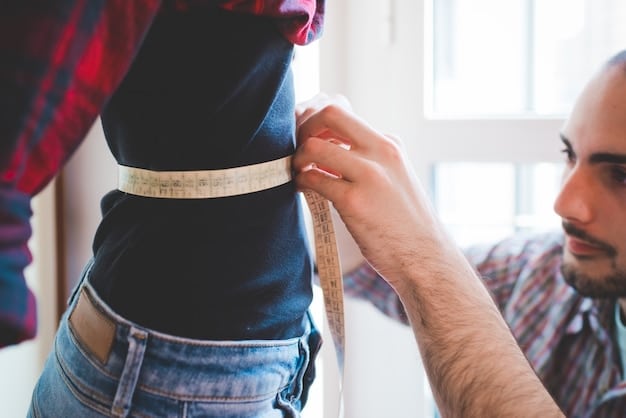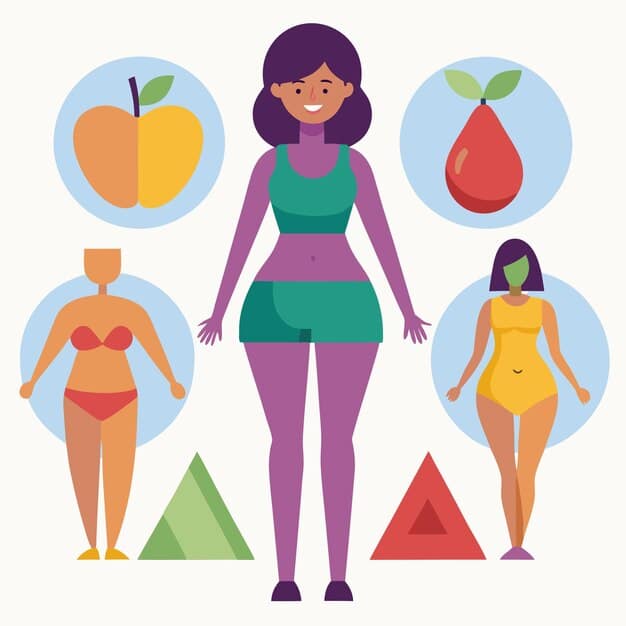Find Your Perfect Fit: Clothing Sizes & Alterations Guide

Finding the perfect fit in clothing involves understanding standard sizing, knowing your body measurements, and considering alterations. This guide provides a comprehensive overview of clothing sizes and alterations for a well-fitted wardrobe.
Ever struggled to find clothes that truly fit and flatter your body? Understanding clothing sizes and knowing when and how to make alterations are key to achieving a perfect fit. Let’s explore how to find the perfect fit: a comprehensive guide to understanding clothing sizes and alterations, ensuring you always look and feel your best.
Understanding Standard Clothing Sizes
Navigating the world of clothing sizes can feel like deciphering a secret code. Standard sizes are meant to provide a uniform guideline, but variations exist across brands and clothing types. Understanding this system is the first step to finding clothes that fit well.
The Flaws of Standard Sizing
One of the primary issues with standard sizing is its inconsistency. What might be a size 6 in one store could be a size 8 in another. This discrepancy arises because there’s no universally enforced standard. Each brand uses its own measurements, leading to size variations.
Moreover, standard sizes are often based on outdated body measurements. The average body shape has changed over the years, yet many brands continue to use the same sizing charts developed decades ago. This can result in clothes that don’t accurately reflect the proportions of modern bodies.

Decoding Size Charts
To mitigate the inconsistency of standard sizes, it’s essential to consult size charts provided by each brand. These charts typically include measurements for bust, waist, hips, and inseam. By comparing your own measurements to the chart, you can select the size that best corresponds to your body.
- Measure Yourself Accurately: Use a flexible measuring tape and stand in front of a mirror to ensure the tape is level.
- Compare Measurements: Don’t rely solely on the size number; compare your measurements to the chart.
- Consider the Garment Type: Different garments may require different fits. For example, a fitted blouse will need more precise sizing than a loose-fitting dress.
Understanding standard clothing sizes can be challenging due to inconsistencies across brands and outdated sizing charts. By familiarizing yourself with size charts and accurately measuring yourself, you can increase your chances of finding clothes that fit well.
Taking Accurate Body Measurements
Accurate body measurements are essential for determining the correct clothing size and ensuring a proper fit. Whether you’re shopping online or in-store, knowing your measurements will help you make informed decisions. Here’s how to take accurate body measurements.
Essential Tools for Measuring
The most important tool for taking body measurements is a flexible measuring tape. You’ll also need a full-length mirror to ensure the tape is level and properly positioned. It’s helpful to have a friend assist you, especially for measurements like back width.
Wear minimal clothing while measuring to ensure accuracy. Lightweight, form-fitting clothes are ideal. Avoid bulky sweaters or multiple layers that can distort your measurements.
Key Measurements to Know
Several key measurements are crucial for finding well-fitting clothes. These include:
- Bust: Measure around the fullest part of your bust, keeping the tape level.
- Waist: Measure around the narrowest part of your waist, typically just above your belly button.
- Hips: Measure around the fullest part of your hips, keeping the tape level.
- Inseam: Measure from the top of your inner thigh to your ankle.
Accurate body measurements are crucial for finding clothes that fit well. By using the right tools, following the correct techniques, and focusing on key measurements, you can ensure a better fit and more satisfying shopping experience.
Understanding Different Body Shapes
Recognizing your body shape is crucial for selecting clothes that enhance your natural figure. Different styles flatter different body shapes, and understanding these principles can dramatically improve how clothes look on you. Here’s an overview of common body shapes.
Identifying Your Body Shape
Common body shapes include:
- Apple (Inverted Triangle): Characterized by broader shoulders and bust compared to the hips and waist.
- Pear (Triangle): Features wider hips than shoulders and bust.
- Hourglass: Defined by balanced bust and hips with a narrow waist.
- Rectangle (Straight): Exhibits similar measurements for shoulders, waist, and hips.
To determine your body shape, stand in front of a mirror in form-fitting clothing. Observe the proportions of your shoulders, bust, waist, and hips. If you’re unsure, take measurements and compare them to the descriptions above.
Clothing Styles for Each Body Shape
Once you’ve identified your body shape, you can choose clothing styles that complement your figure. Here are some general guidelines:
- Apple: Look for styles that add volume to the lower body, such as A-line skirts or flared pants.
- Pear: Choose garments that balance the upper body, like tops with embellishments or structured shoulders.
- Hourglass: Emphasize your waist with fitted dresses, belts, or high-waisted bottoms.
- Rectangle: Create curves with ruffles, ruching, or fit-and-flare silhouettes.

Understanding different body shapes is essential for choosing clothes that flatter your figure. By identifying your body shape and selecting styles that complement your proportions, you can enhance your natural beauty and feel more confident in your clothing.
The Importance of Fabric and Fit
The fabric and fit of a garment significantly impact its overall appearance and comfort. Understanding how different fabrics drape and how they should fit your body is essential for making smart clothing choices. Let’s dive into the importance of fabric and fit.
How Fabric Affects Fit
Different fabrics behave differently when draped on the body. Some fabrics, like silk and rayon, have a fluid drape that skims the body, while others, like linen and cotton, have a more structured drape. The fabric’s weight and stretch also play a role in how it fits.
For example, a stretchy knit fabric will conform to your body’s curves, providing a close fit. A stiff, non-stretch fabric, on the other hand, will hold its shape and create a more structured silhouette. Consider the fabric’s properties when selecting garments for different occasions.
Achieving the Right Fit
The right fit depends on the garment’s style and your personal preferences. However, some general guidelines apply:
- Shoulders: The shoulder seams should align with the edge of your shoulders.
- Bust: The fabric should lie smoothly across your bust without pulling or gaping.
- Waist: The garment should skim your waist without feeling too tight or too loose.
- Hips: The fabric should drape comfortably over your hips without clinging or restricting movement.
The importance of fabric and fit cannot be overstated. By understanding how different fabrics drape and achieving the right fit, you can enhance your appearance and feel more comfortable in your clothes.
When and How to Alter Clothes
Sometimes, even when you find a garment in your size, it may not fit perfectly. That’s where alterations come in. Knowing when and how to alter clothes can transform ill-fitting items into wardrobe favorites. Here’s what you need to know about clothing alterations.
Common Alterations
Some of the most common clothing alterations include:
- Hemming Pants and Skirts: Adjusting the length of pants or skirts to the desired length.
- Taking in or Letting Out Seams: Adjusting the width of a garment to fit your body more closely or loosely.
- Adjusting Sleeves: Shortening or lengthening sleeves to the correct length.
- Replacing Buttons or Zippers: Repairing or replacing damaged closures.
Finding a Qualified Tailor
For more complex alterations, it’s best to seek the help of a qualified tailor. A good tailor can assess the garment’s fit and recommend alterations that will improve its appearance. Look for a tailor with experience and positive reviews.
When meeting with a tailor, bring the garment you want altered, along with the shoes you plan to wear with it. This will help the tailor determine the correct hem length. Be clear about your desired fit and ask for their professional opinion.
Knowing when and how to alter clothes can significantly improve your wardrobe. By identifying common alterations, deciding between DIY and professional help, and communicating effectively with a tailor, you can transform ill-fitting garments into well-loved pieces.
DIY Alterations vs. Professional Tailoring
Deciding whether to tackle clothing alterations yourself or seek professional tailoring depends on your skill level, the complexity of the alteration, and the value of the garment. Here’s a comparison to help you make the right choice.
Simple DIY Alterations
Simple alterations that you can easily do yourself include:
- Hemming Curtains or Simple Skirts: Requires basic sewing skills and a sewing machine.
- Replacing Buttons: A straightforward task that anyone can learn with minimal equipment.
- Repairing Small Tears: Hand-sewing small tears or holes in fabric.
Before attempting any DIY alterations, make sure you have the necessary tools and skills. Watch tutorials, practice on scrap fabric, and take your time to avoid mistakes.
When to Seek Professional Help
More complex alterations should be left to a professional tailor. These include:
- Altering Fitted Garments: Requires expertise in pattern-making and construction.
- Adjusting Complex Seams: Can be challenging to execute correctly without professional tools and skills.
- Working with Delicate Fabrics: Requires careful handling and specialized techniques.
DIY alterations can be cost-effective for simple tasks, while professional tailoring ensures high-quality results for complex alterations. Assess your skills, the complexity of the alteration, and the value of the garment to make the best decision for your needs.
| Key Point | Brief Description |
|---|---|
| 📏 Accurate Measurements | Use a measuring tape to get precise body measurements for better clothing fit. |
| 🍎 Body Shape Awareness | Understand your body shape (apple, pear, hourglass, etc.) to select flattering styles. |
| 🧵 Alterations | Know when to DIY simple alterations and when to seek professional tailoring. |
Frequently Asked Questions
▼
Clothing sizing varies because there is no universal standard. Each brand uses its own measurements and sizing charts, leading to discrepancies. Always check the brand’s size chart before purchasing.
▼
Use a flexible measuring tape, stand in front of a mirror to ensure the tape is level, and measure key areas like bust, waist, and hips. Wear minimal clothing for accuracy.
▼
Common alterations include hemming pants and skirts, taking in or letting out seams, adjusting sleeves, and replacing buttons or zippers. These can greatly improve the fit of your clothes.
▼
Seek professional help for complex alterations, such as altering fitted garments, adjusting complex seams, or working with delicate fabrics. A tailor ensures high-quality results.
▼
Fabric type influences how a garment drapes and fits. Stretchy fabrics conform to the body, while stiff fabrics hold their shape. Consider fabric properties when choosing clothes for different occasions.
Conclusion
Finding the perfect fit in clothing involves understanding sizing inconsistencies, knowing your body measurements, recognizing your body shape, considering fabric and fit, and utilizing alterations. By applying these principles, you can build a wardrobe of well-fitted clothes that make you look and feel your best.





